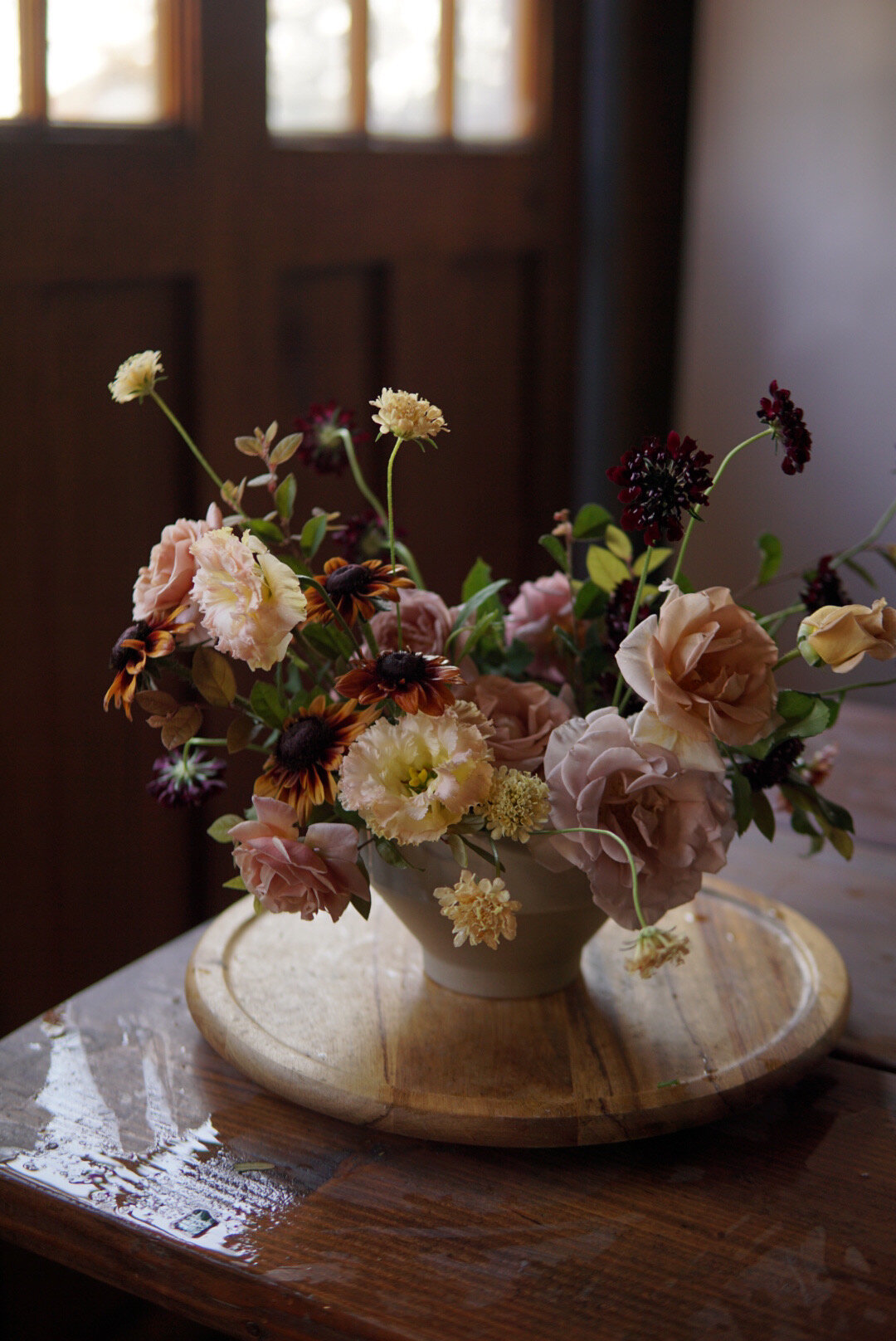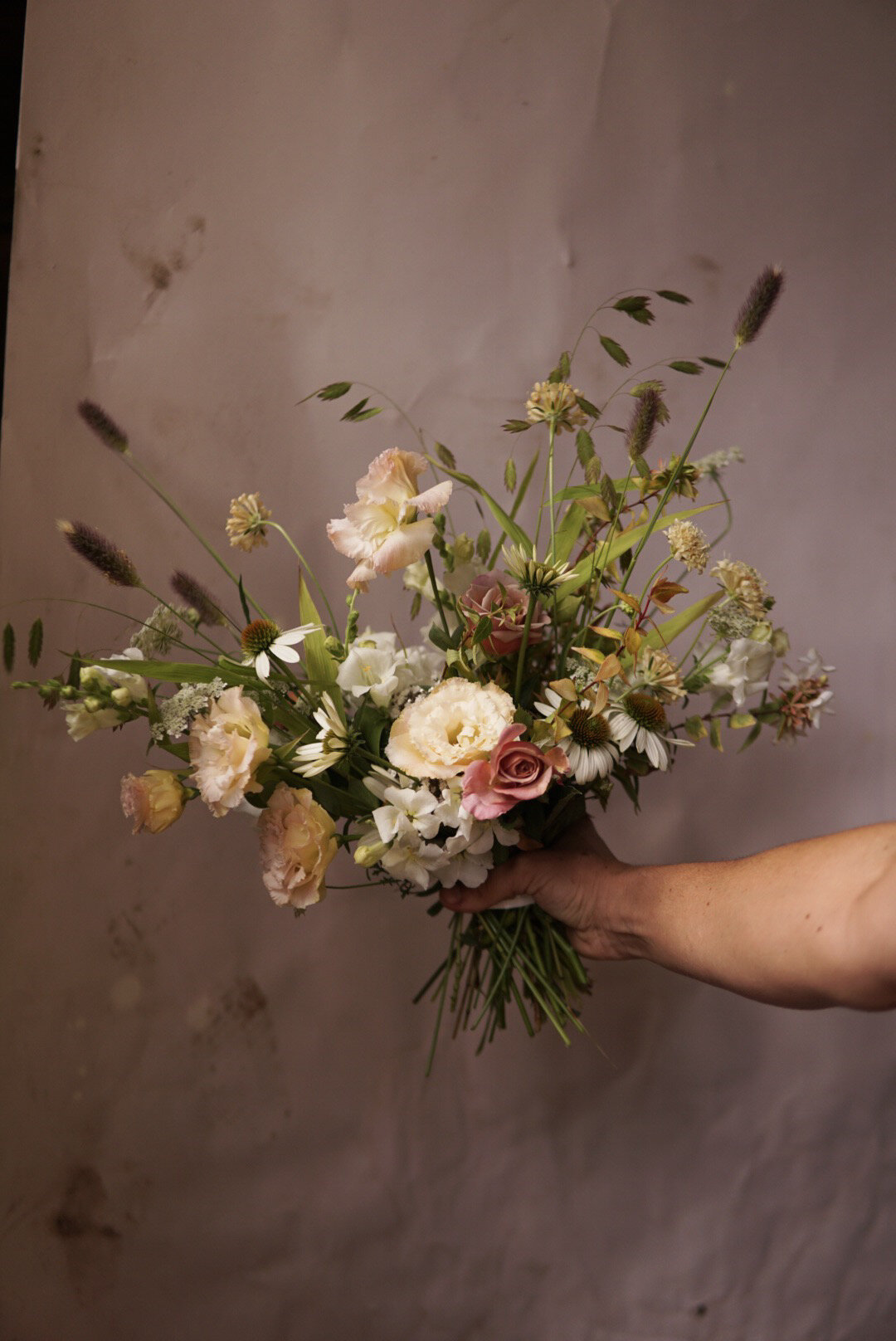Bewilder Floral
I sleep with my curtains open so I can catch the first morning light as it paints the far corners of the garden. Sunlight outlines the vines growing up my window, creating shadows on the walls as I pull on my overalls and slip on my boots. Coffee in hand, I fill a bucket of water, find my clippers and tromp off to discover what unfurled in the night.
An ikebana instructor once told me, “an arrangement begins with a walk through the garden.” I note what the leaves are doing—in spring they are fresh and verdant, in fall they are crisp and dry. I inspect each flower—stretching towards the sunlight and fading slightly in color with each day.
To garden is to commune with the soil and the seasons, the plants are simply our shared language. In the small ecosystem I am building, birds and lizards scavenge for small insects, rodents and squirrels feed on nuts, owls and hawks hunt for gophers. It is an entire world unto itself—my world.
The funny thing is I never set out to be a florist. As an art student, I simply needed a job—any job—and in 2010 I found myself working at a local bucket shop to help support myself through school. At first I was put off by the fussy clientele and the carbon footprint of flying luxury stems around the world, until I discovered the beauty of locally sourced stems.
Collecting wildflowers and visiting biologically diverse farms dissolved the hierarchy of expensive flowers and brought a simple pleasure to everyday life. Watching my foraged treasures change and fade by my bedside was a luxury unto itself.
But it wasn’t until a personal loss that I understood the true meaning of flowers. My partner, an artist whom I thought would be with me for life, died overnight in an avalanche and his body was never found. All plans however carefully laid fell away and I was left to make my life anew.
I found solace in old growth trees with their histories of fires made plain on their bark, in the relentless yet reliable crashing of waves that formed pebbles on the beach, and the wildflowers that heard their season calling them forth from deep in the earth, then dispersed as quickly as they arrived. It was eight months before I could return to work, but when I did it was in flowers.
In a floral shop in Santa Cruz my healing began. Feeling a certain kinship to the unsold flowers, I began to save the heads of the older flowers, just as one does in their earliest flower days before the novelty wears off. I loved the way their color changed in their decay, and the particular translucency of the petals as they dried. I admired how even in death, they retained their beauty.
After hours, I began a ritual of arranging them in increasingly elaborate patterns on the floor. Like a sand mandala, I would then ceremoniously sweep them up in an act of letting go. My connection with flowers comes from what can be the most challenging aspect about them—the fact that they fade. I believe their graceful ephemerality can help us to accept our own.
There is fertility in decay. Glorious wedding flowers that once marked a happy occasion will turn black with rot in my compost pile, and go on to feed another flower for another day. Beauty emerges from hardship, and the cycle begins again. We all are a part of this rhythm, though modern life often lets us forget.
Flowers and plants have the power to connect us back to nature, and so in my arrangements I aim to do just that. Rather than simply filling up space, I look to the teachings of ikebana for inspiration. Imperfect, bug eaten or wind ruffled leaves are all allowed—reflecting the time and place they are in. Instead of importing expensive flowers from another time and place, each blossom is intentional and tells a story. A fall arrangement is a celebration of that moment in the patinae of the leaves and texture of dried flowers, but it also leaves room for longing for what once was, when the world was green in springtime.
At it’s best, floristry is a practice of accepting things as they are, living in the present moment, and making the choice to find beauty wherever it may be hiding. Cultivating a connection with plants and flowers can help us see ourselves as a part of the larger lifecycle, rather than independent actors. We can learn to hold the natural world and one another with the gentleness we hold each stem, considering how our actions may deplete our resources or help to rebuild them.
…
Larisa Minerva is a California native deeply inspired by the cycles of nature. While attending California College of the Arts to study film, sculpture, and writing, she fell into her first floral shop job in 2010. Concerned with the environmental impacts of floral imports, it was not necessarily an industry she could see herself in until she discovered the particular beauty of local and foraged flowers. From there, Larisa’s relationship with the ephemeral medium deepened after the loss of a loved one and her subsequent volunteer work arranging flowers for patients in the Zen hospice project.
Larisa founded Bewilder Floral in 2016 and is now an avid gardener in Palo Alto, California. Exclusively working with garden grown and locally sourced materials, she pulls inspiration from the hyper seasonality of flowers and the natural landscape in which they will be seen. Through her work, she aims to evoke our deep and inherent connection to nature so that we might better see ourselves as part of a larger whole.



